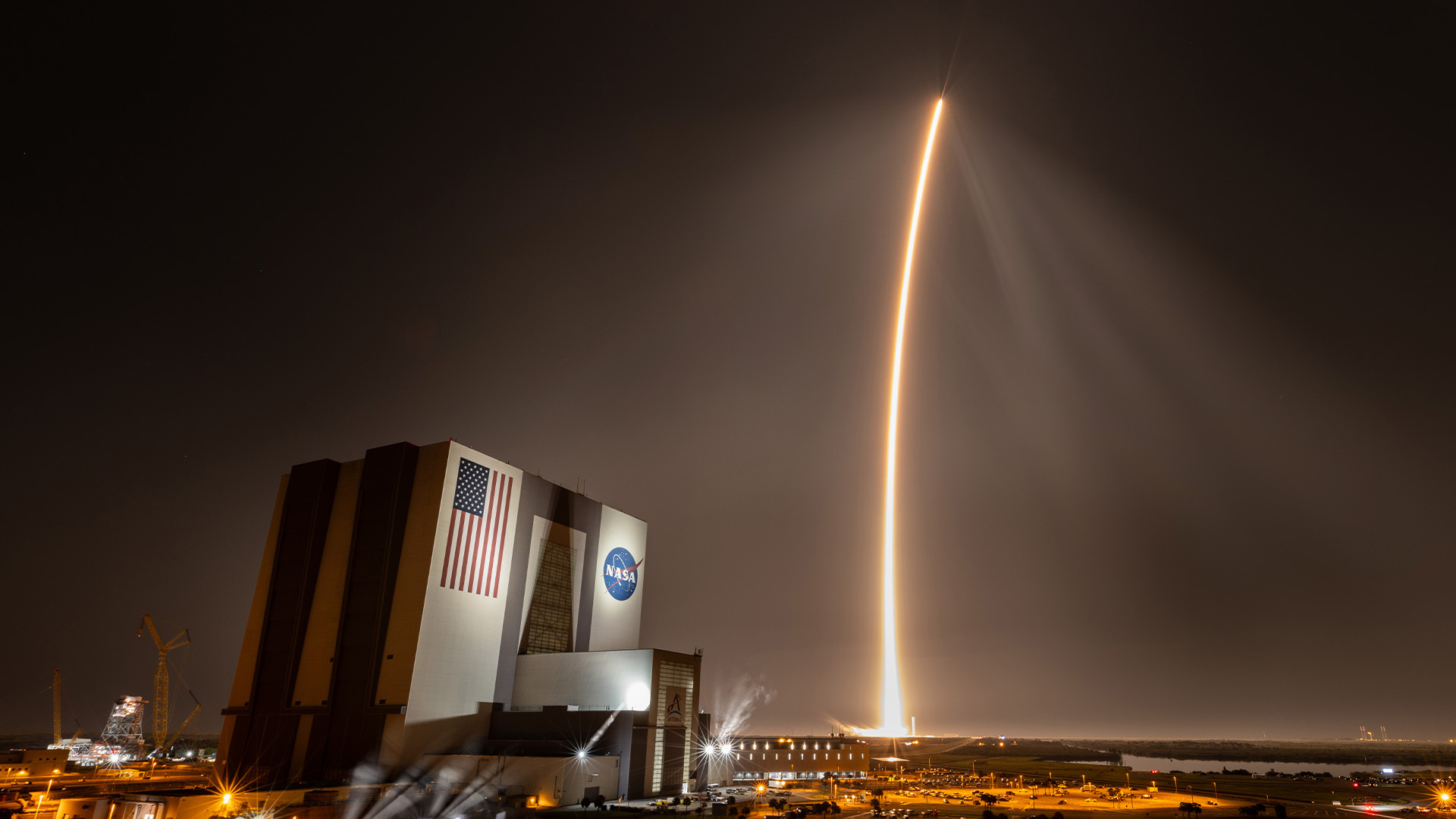
NASA, SpaceX launch mission to the moon with goal of finding lunar water
By Jack Aylmer (Energy Correspondent), Emma Stoltzfus (Video Editor)
- A SpaceX Falcon 9 rocket is heading to the moon after launching from NASA’s Kennedy Space Center, carrying the Athena lunar lander and Lunar Trailblazer orbiter. The mission’s goal is to find lunar water and determine if there is enough of it to support eventual human habitation in space.
- Athena will attempt a landing near the moon’s south pole to search for water ice, while Lunar Trailblazer will map water deposits from orbit.
- NASA increased funding from $47 million to $62.5 million to support additional data collection, aiming to inform future lunar exploration and potential human missions.
Full Story
A new lunar mission is currently underway, with a goal of finding water on the moon. On Wednesday, Feb. 26, a SpaceX Falcon 9 rocket successfully launched from NASA’s Kennedy Space Center, carrying the Athena lunar lander and NASA’s Lunar Trailblazer orbiter.
Media Landscape
See how news outlets across the political spectrum are covering this story. Learn moreBias Summary
- No summary available because of a lack of coverage.
- NASA launched the Lunar Trailblazer satellite to locate water on the moon, focusing on permanently shadowed craters at its poles.
- The Lunar Trailblazer will map lunar water and perform flybys over several months using a SpaceX Falcon 9 rocket.
- The mission aims to gather data about water abundance and distribution, which is crucial for future lunar exploration.
- No summary available because of a lack of coverage.
Bias Distribution
Left
Right
Untracked Bias
“I’m very excited to see the science that our tech demonstrations deliver as we prepare for humanity’s return to the moon,” Nicky Fox, associate administrator of NASA’s Science Mission Directorate, said.
How long will the mission take?
The lander is expected to reach lunar orbit in four to five days, with a landing attempt planned one to three days later. If successful, Athena will operate near the Moon’s south pole for approximately 10 Earth days.

Download the SAN app today to stay up-to-date with Unbiased. Straight Facts™.
Point phone camera here
This mission is part of NASA’s Commercial Lunar Payload Services program, which partners with private companies to deliver science and technology payloads to the lunar surface.
How does the mission aim to accomplish its goals?
Once on the surface, Athena will use NASA science instruments to search for water ice beneath the lunar surface. The mission aims to determine whether there is enough water to support potential future human habitation in space. Two secondary vehicles will also be deployed to explore the surrounding terrain.
Meanwhile, NASA’s Lunar Trailblazer will operate from lunar orbit, mapping water ice deposits across the Moon. NASA originally allocated $47 million for these efforts but later increased the total to $62.5 million to support additional data acquisition.
What happens next?
As the mission progresses, scientists and engineers will analyze data from Athena and Lunar Trailblazer to guide future lunar exploration initiatives, including potential human missions to the moon.
A NEW MISSION TO THE MOON IS NOW UNDERWAY-
WITH A GOAL OF FINDING LUNAR WATER.
LAST NIGHT, A SPACEX FALCON 9 ROCKET SUCCESSFULLY LAUNCHED FROM NASA’S KENNEDY SPACE CENTER-
CARRYING THE ATHENA LUNAR LANDER AND NASA’S LUNAR TRAILBLAZER ORBITER.
ATHENA IS PART OF NASA’S COMMERCIAL LUNAR PAYLOAD SERVICES PROGRAM- WHICH COLLABORATES WITH PRIVATE COMPANIES TO DELIVER SCIENCE AND TECHNOLOGY PAYLOADS TO THE LUNAR SURFACE.
THE LANDER IS EXPECTED TO REACH LUNAR ORBIT IN FOUR TO FIVE DAYS AND ATTEMPT A LANDING ONE TO THREE DAYS LATER-
IF SUCCESSFUL, IT WILL OPERATE NEAR THE MOON’S SOUTH POLE FOR APPROXIMATELY TEN EARTH DAYS.
ONCE IT TOUCHES DOWN, ATHENA WILL USE NASA SCIENCE INSTRUMENTS TO SEARCH FOR WATER ICE BENEATH THE LUNAR SURFACE.
THE OBJECTIVE IS TO DETERMINE WHETHER THERE’S ENOUGH WATER HERE TO POTENTIALLY UTILIZE FOR SUSTAINABLE HUMAN HABITATION IN SPACE.
TWO SECONDARY VEHICLES WILL ALSO BE DEPLOYED TO EXPLORE THE SURROUNDING TERRAIN.
MEANWHILE, NASA’S LUNAR TRAILBLAZER WILL OPERATE IN LUNAR ORBIT, MAPPING WATER ICE DEPOSITS ON THE MOON.
NASA ORIGINALLY ALLOCATED 47 MILLION DOLLARS FOR FUNDING THESE EFFORTS-
BUT LATER INCREASED THAT TOTAL TO 62.5 MILLION DOLLARS DUE TO ADDITIONAL DATA ACQUISITION REQUESTS.
AS THE MISSION PROGRESSES, SCIENTISTS AND ENGINEERS WILL ANALYZE FINDINGS FROM ATHENA AND LUNAR TRAILBLAZER TO INFORM FUTURE LUNAR EXPLORATION EFFORTS-
INCLUDING HUMANITY’S EVENTUAL RETURN TO THE MOON.
FOR STRAIGHT ARROW NEWS, I’M JACK AYLMER.
Media Landscape
See how news outlets across the political spectrum are covering this story. Learn moreBias Summary
- No summary available because of a lack of coverage.
- NASA launched the Lunar Trailblazer satellite to locate water on the moon, focusing on permanently shadowed craters at its poles.
- The Lunar Trailblazer will map lunar water and perform flybys over several months using a SpaceX Falcon 9 rocket.
- The mission aims to gather data about water abundance and distribution, which is crucial for future lunar exploration.
- No summary available because of a lack of coverage.
Bias Distribution
Left
Right
Untracked Bias
Straight to your inbox.
By entering your email, you agree to the Terms & Conditions and acknowledge the Privacy Policy.
MOST POPULAR
-
 Getty Images
Getty Images
Republicans ‘Rickroll’ the Epstein files, receive blowback from users
Read4 hrs ago -
 Getty Images
Getty Images
Friday’s ‘economic blackout’ boycott is missing a key ingredient: Expert
Watch 9:577 hrs ago -
 Getty Images
Getty Images
Actor Gene Hackman, wife and dog found dead in Santa Fe home
Watch 0:4413 hrs ago -
 Getty Images
Getty Images
Nevada Gov. Lombardo, AG Ford disagree over immigration policies
Watch 2:4421 hrs ago




